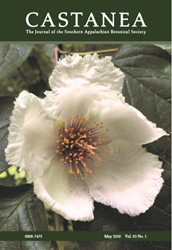Survey Aims to Help Keep Alabama Forever Wild
 Castanea – As human development increasingly intrudes upon America’s wild spaces, another development has been occurring: the creation of trusts and other organizations that buy private land to open for public use. Although such land transfers can take years to finalize, management plans that balance conservation with recreation often must be put into place quickly. In many areas, including Alabama’s Forever Wild tracts, the first steps include an initial survey of plants and wildlife.
Castanea – As human development increasingly intrudes upon America’s wild spaces, another development has been occurring: the creation of trusts and other organizations that buy private land to open for public use. Although such land transfers can take years to finalize, management plans that balance conservation with recreation often must be put into place quickly. In many areas, including Alabama’s Forever Wild tracts, the first steps include an initial survey of plants and wildlife.
The current issue of Castanea presents an in-depth study of the plants growing in Alabama’s Freedom Hills Forever Wild Tract, whose 13,800 hectares (34,100 acres) are managed by the state’s Department of Conservation and Natural Resources. Parts of the property protect critical plant and wildlife habitats, while other areas are open to recreational and outdoor educational uses. The researchers created a list of the plants that managers can turn to as they monitor how the area’s multiuse programs affect its extreme biodiversity.
Over a five-year period, researchers collected 757 plant species from the tract. In their survey of plants growing on the property, they gathered and identified samples that were then verified against established collections. Amid a large range of plant species, they discovered many that are rarely found in Alabama or even neighboring states.
According to the survey, flowering species make up 96% of the plants. Most are native members of the daisy family, but rare discoveries included French’s shooting star and Alabama warbonnet. Grasses and sedges also dominate the area, which lies just 450 to 1,000 feet above sea level.
“The Freedom Hills Forever Wild Tract is a great example of how the multi-use programs implemented by the Alabama Department of Conservation can provide opportunities for a myriad of outdoor enthusiasts,” said author Wayne Barger. “The tract is managed as a Wildlife Management Area open for public hunting but also protects critical habitats such as the cliff overhangs where the rare French’s shooting star is found. Many opportunities afforded by the Forever Wild Program for hiking, bird watching, botanical discovery and even horseback riding all fit into the management of this highly biodiverse tract.”
Barger emphasized that his group’s assessment “acts as an important baseline for establishing the floral biodiversity of an area.” As the Forever Wild Program continues to grow in Alabama, such surveys can help ensure a balance of public use, outdoor education and habitat conservation.
Full text of the article “The Vascular Flora of the Freedom Hills Forever Wild Tract, Colbert County, Alabama,” Castanea, Vol. 83, No. 2, 2018, is now available at http://www.bioone.org/doi/full/10.2179/18-169.
About Castanea
Castanea is the journal of the Southern Appalachian Botanical Society and publishes articles relating to all aspects of botany in the entire eastern United States and adjoining areas. The southern Appalachians—the nonglaciated, mountainous areas of Alabama, Georgia, South Carolina, North Carolina, Tennessee, Kentucky, Virginia, West Virginia, Maryland, Pennsylvania, and southwestern New York—form an evolutionary center for native plant diversity for the northern temperate regions of the world. The society dates to 1935 and serves all persons interested in the botany of the southern Appalachian Mountains. The journal encourages submissions of scientific papers dealing with basic research in any field of plant biology, systematics, floristics, ecology, physiology and biochemistry. For more information about the journal or the society, please visit: http://www.castaneajournal.org or http://www.sabs.appstate.edu.
Comments
Videos
